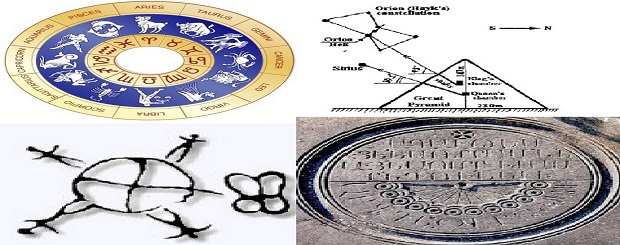
The Oldest Calendar – (AOC AND AFC) – Art-A-Tsolum
January 20, 2018 – Antiquities, History – Art-A-Tsolum:
In Armenia the Solar Calendar was in use for all times. And this is understandable because the Sun was the Main God. There is no data that the Moon calendar was ever used, although it was known and the Moon period of rotation around Earth was not difficult to measure.
Prehistoric astronomers looking through any Single “Sun-Stone” Hole (or using other older simple instruments) could fix the azimuth (position on horizon) of Sunrise (or Sunset) point at any day and define (even without pipe) that this point moves along the horizon from day to day for value up to 30 arc min, at days close to the equinox days, which is almost equal to the angular diameter of Sun (32′), and comes back to the same first position (from the same side) after 365 days, which made one year.
It is obvious that such a simple observation could be done much earlier than the time of developed Karahunj, when for agricultural and other work the calendar becomes necessary. That time was, perhaps, about 23 thousand years ago when the Armenian Oldest Calendar (AOC) was established having the beginning of year on the Spring equinox day Areg 1 (now March 21)*.
It was also defined that once per year, in Summer Solstice the star Sirius rises just before Sunrise, i.e, the year by Sirius also includes 365 days as Solar year has. This takes place because of accidental combination of precession and self movements of Sirius.
This Solar AOC was so-called “movable”. The festal days slowly moved along all year round (with period of 1461 years) because real Solar year includes about a quarter day more than 365 days (365.25 : 0.25=1461). The developed Karahunj Observatory (7500 years ago) gave much better possibilities to make observations during many years and with much higher accuracy (30″ or 2 sec. of time with pipes).
So at that time it was found out that Solar year consists of about 365.25 days. So to “stop” the ”movable” calendar, i.e. to “fIX” the festal days with the Sun real movement during the year, it was necessary to add in Calendar one more day once per four years.
Thus the ”fixed” (immovable) Calendar was invented and developed in Karahunj with the moment of year beginning at 6 o’clock in the morning (or in midday) of Spring equinox day, at Areg 1 (March 21). Thus Armenian Fixed Calendar (AFC) was established in Karahunj, and the period of 1461 years was called ”the Armenian period”.
Armenians used both ”movable” and ”fixed” calendars in parallel more than five thousand years (up to the end of XIX century AD), and taught people of other countries these calendars, especially Sumers and Egyptians whose civilizations began in DI millennium BC.
Using both AOC and AFC during very long time Armenian astronomers found out that the additional quarter day in year (365.25)being accumulated in ”movable” calendar gives one whole year after each 1461 years (0.25 x 1461 = 365.25).
This period of 1461 years (or 1460 for “fixed calendar”) was called the “Armenian period” (or “Armenian cycle”). The same duration has “Sirius cycle”, or so-called “Sotis” •. It was corrected later that Armenian cycle and Sirius cycle have a little difference of 12 days, Le, 12 min. per year (0.002%) because the Solar year has a little less duration (365.242 days), than Sirius year (365.25 days).
AFC as well as Armenian Cycle and Sotis were known and were in use also in Old Egypt [19]. The ”fixed” calendar, of course, is more convenient in using. It entered Europe by July Caesar (with the help of Egyptian astronomers, as Sosigen from Alexandria) on January 1, 45 BC (so-called “Old Style”) and later it was corrected by Pope Gregory DI (with the help of Polish astronomer Copernicus) in 1582 AD (“New Style”, which is in use now)’”, Armenia admitted the Julian calendar in 122 AD (by King Artashes D)
 • Perhaps at that time, in 22946 BC, the Armenian favourite old God Vahagn (fighter of dragons and evil) ”was born”. The value 22946 years comes from the supposition that these events took place 14 “Armenian periods” before Armenian King Hayk’s victory in 2492 BC (14 x 1461+2492=22946). So later Armenian period was called also the “Haykian period”.
• Perhaps at that time, in 22946 BC, the Armenian favourite old God Vahagn (fighter of dragons and evil) ”was born”. The value 22946 years comes from the supposition that these events took place 14 “Armenian periods” before Armenian King Hayk’s victory in 2492 BC (14 x 1461+2492=22946). So later Armenian period was called also the “Haykian period”.
* Let me note that “Sirius” or “Sotis” means in Armenian “The loved one in the house of Holyperson”, where Holy person is perhaps Armenian King Hayk. In Old Egypt there was a festal day “Siruhis” which in Armenian is “My beloved woman” (see also Fig.44).
**To turn to Old Style it is necessary now to add to the date 12 days. 28
An extract from the book “Armenians and Ancient Armenia” by Paris Herouni.
To date, The Prehistoric Wonder in Armenia Karahunj is included in the Top Ancient Sites for Stargazing in National Geographic

Photo provided by Nana Herouni




Photo provided by Nana Herouni






Photo provided by Nana Herouni

allinnet.info/antiquities/the-oldest-calendar-aoc-and-afc/?
